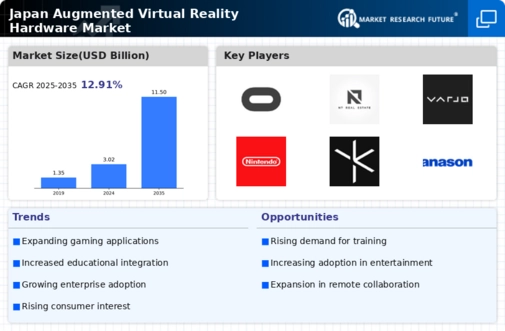The augmented virtual-reality-hardware market in Japan is characterized by a dynamic competitive landscape, driven by rapid technological advancements and increasing consumer demand for immersive experiences. Key players such as Sony (JP), Meta Platforms (US), and Microsoft (US) are at the forefront, each adopting distinct strategies to enhance their market positioning. Sony (JP) focuses on integrating its gaming ecosystem with virtual reality, leveraging its PlayStation platform to attract a dedicated user base. In contrast, Meta Platforms (US) emphasizes social connectivity through its VR offerings, aiming to create a metaverse that fosters user interaction. Microsoft (US) is strategically positioning itself in enterprise solutions, utilizing its HoloLens technology to cater to business applications, thereby diversifying its market reach. Collectively, these strategies contribute to a competitive environment that is increasingly innovation-driven, with companies vying for technological supremacy and user engagement.
The business tactics employed by these companies reflect a nuanced understanding of the market's structure, which appears moderately fragmented yet competitive. Localizing manufacturing and optimizing supply chains are critical tactics that enhance operational efficiency and reduce costs. For instance, companies are increasingly investing in local production facilities to mitigate supply chain disruptions and respond swiftly to market demands. This localized approach not only strengthens their market presence but also aligns with consumer preferences for domestically produced goods, thereby enhancing brand loyalty.
In October 2025, Sony (JP) announced the launch of its latest VR headset, which integrates advanced eye-tracking technology, significantly enhancing user interaction and immersion. This strategic move is pivotal as it positions Sony to capture a larger share of the gaming market, appealing to both casual and hardcore gamers. The incorporation of eye-tracking technology is expected to set a new standard in user experience, potentially influencing competitors to innovate further.
In September 2025, Meta Platforms (US) unveiled a partnership with several Japanese content creators to develop exclusive VR experiences tailored for the local market. This initiative underscores Meta's commitment to localizing content, which is crucial for user engagement in Japan's unique cultural landscape. By fostering relationships with local creators, Meta not only enhances its content library but also strengthens its brand presence in a competitive market.
In November 2025, Microsoft (US) expanded its HoloLens distribution in Japan by collaborating with local enterprises to implement augmented reality solutions in various sectors, including healthcare and manufacturing. This strategic expansion is indicative of Microsoft's focus on enterprise applications, which may provide a more stable revenue stream compared to consumer markets. By aligning its technology with local business needs, Microsoft is likely to solidify its position as a leader in the enterprise AR segment.
As of November 2025, the competitive trends in the augmented virtual-reality-hardware market are increasingly shaped by digitalization, sustainability, and AI integration. Strategic alliances are becoming more prevalent, as companies recognize the value of collaboration in enhancing technological capabilities and market reach. Looking ahead, competitive differentiation is expected to evolve, with a pronounced shift from price-based competition to a focus on innovation, technology, and supply chain reliability. This transition may redefine market dynamics, compelling companies to invest in cutting-edge technologies and sustainable practices to maintain a competitive edge.























Leave a Comment